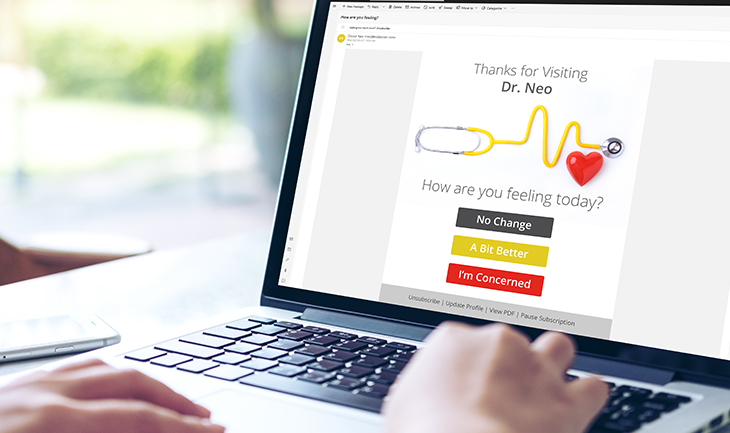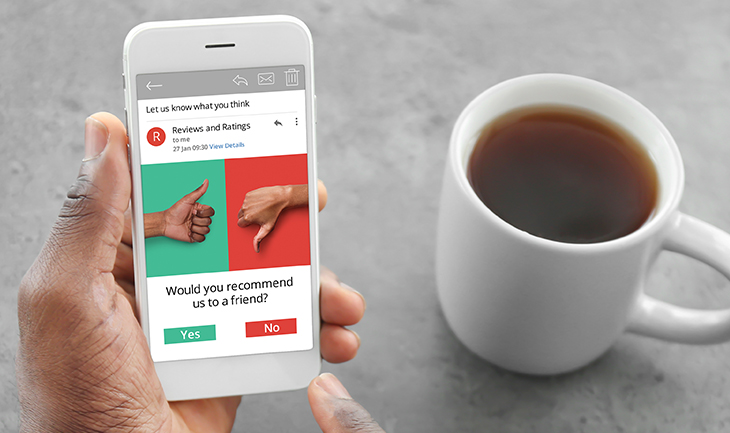A fear many people have when it comes to automated communication is the loss of humanity – especially since meaningful experiences are a top communication trend. But what most people don’t realise is, in today’s frantic world, email automation can actually help humanise your business – creating mutually beneficial relationships for you and your clients. Here are a few ways you can do this in the industry where professionals are punished harshly for a lack of humanity: medicine.

Why Automate Medical Communication?
The ultimate reason why it’s valuable to automate communication in the medical industry is because in a field that’s so human, so intimate, quality of communication is critical… But in the busy world and businesses we live and work in, we don’t always have the capacity to do it well. And this can have two major ramifications:
- Medical professionals run the risk of bad reviews or medical malpractice suits.
- Medical organisations lose business.
For Medical Professionals
According to Sonia Henry, a family medicine resident in Australia, “doctors who make mistakes are much less likely to suffer litigation if they treated their patients like people rather than an error they want to escape from”. An article in Physicians Practice echoes this, saying studies show that poor communication is the most common complaint associated with medical malpractice suits.
In other words: in an industry as sensitive as medical care, communication can make or break your practice. This isn’t to say that all medical negligence is related to poor communication, or that all you need to do is communicate better and you won’t get into trouble for medical malpractice. What it does say is that the quality of your communication has a notable impact on patients and it’s worth putting systems in place to improve it.
Even if it isn’t litigation you’re concerned about, an improved patient experience builds better long-term relationships and keeps patients coming back to you as their practitioner of choice. If you’re not the kind of practitioner patients hope to visit regularly (oncology comes to mind), a positive patient experience increases positive reviews and referrals too.

For Medical Organisations
A medical business is still a business. And that means keeping patients engaged and informed about their medical processes is good for the longevity of your organisation. Improve communication – and automate it – and you improve engagement, building sustainable relationships without adding extra load to your workforce.
Automated Emails for Patient Engagement
There are endless ways that you as a medical professional can communicate automatically with patients – especially if your patient scheduling system is integrated with a messaging automation platform like Everlytic. Cardinal Digital Marketing suggests three message automation types that can get the most impact now.
- Use Follow-Up Emails to Keep Patients Updated
A great way to keep connected with patients is to trigger an automated follow-up email a day or two after they visit your facility – this is easiest when your messaging is integrated with an appointment system that records when a patient visits you. Automation like this ensures that the patient feels an extra sense of care, it enables you to follow up on any prescribed treatment, and it opens the channels of communication if there’s something on their mind that they’re thinking of discussing with you.
Follow-up emails aren’t the only way to do this. You can also trigger automated emails sent out annually, reminding patients to come for a check-up. Or, if your practice requires step-by-step aftercare or preparatory behaviour before their appointment, you can trigger automated journeys guiding them through this. Alternatively, if there are specific patient milestones based on age or time between appointments, you can automate these too.
Think about how your practice functions to conceptualise a journey that supports you and your patients best, holding their hands without impacting your team’s capacity.

- Start Meaningful Conversations with Review Requests
Communication is a two-way street. So, sometimes, it isn’t necessarily that you didn’t communicate well – it may also be that they didn’t. This is where following up with a review-request email comes in handy: it invites open communication.
It could be as simple as asking “Would you recommend us to a friend?”. If they click the YES button, direct them to an online review site like Google or Facebook. If they click the NO button, direct them to an online form, where they can send their concerns directly to you first. This keeps communication between you and the patient (at least for now) and prevents complaints going public online – or beyond – without you having a chance to address it first.

- Send Newsletters to Keep Your Practice Top of Mind
Most people just deal with doctors when they need to – communication is sporadic and case specific, making relationship building tricky. A great way to keep the conversation going, and to keep your services top of mind, is to send out a monthly newsletter. This can include updates on what’s happening in your practice, health tips, testimonials, current research in your specialty, stories, personal sentiments, and more.
The content in your newsletter doesn’t need to end there either. You can also share the information on your website and social media – getting more mileage from your efforts.
Approaching your relationship with patients as an ongoing conversation like this increases awareness of your field and positions you as their go-to expert when they need you.
Connection is Key in the Medical Industry
As Sonia Henry says in her article, “Sometimes patient care does not involve a cure and all that can be done is the acknowledgement of the fact we have tried, and to be there regardless.” By using automations like this, you can steep this culture of connection and communication into your service, the patient experience, and your medical organisation.
Updated 14 June 2022.












